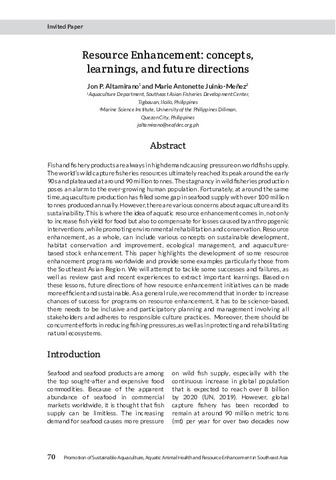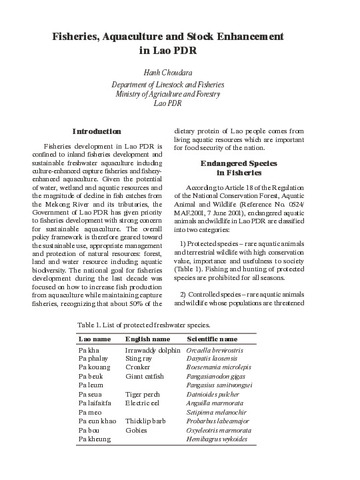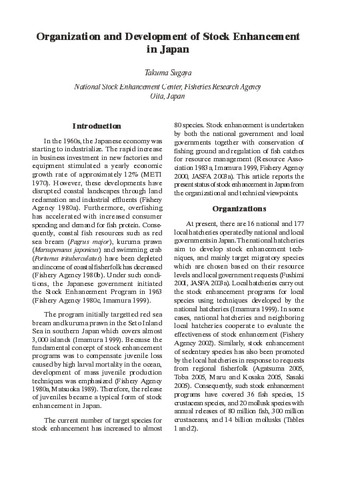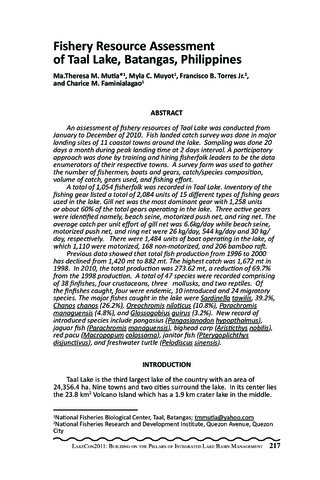Resource enhancement: Concepts, learnings, and future directions
- Global styles
- MLA
- Vancouver
- Elsevier - Harvard
- APA
- Help
Share
抄録
Fish and fishery products are always in high demand causing pressure on world fish supply. The world’s wild capture fisheries resources ultimately reached its peak around the early 90s and plateaued at around 90 million tonnes. The stagnancy in wild fisheries production poses an alarm to the ever-growing human population. Fortunately, at around the same time, aquaculture production has filled some gap in seafood supply with over 100 million tonnes produced annually. However, there are various concerns about aquaculture and its sustainability. This is where the idea of aquatic resource enhancement comes in, not only to increase fish yield for food but also to compensate for losses caused by anthropogenic interventions, while promoting environmental rehabilitation and conservation. Resource enhancement, as a whole, can include various concepts on sustainable development, habitat conservation and improvement, ecological management, and aquaculturebased stock enhancement. This paper highlights the development of some resource enhancement programs worldwide and provide some examples particularly those from the Southeast Asian Region. We will attempt to tackle some successes and failures, as well as review past and recent experiences to extract important learnings. Based on these lessons, future directions of how resource enhancement initiatives can be made more efficient and sustainable. As a general rule, we recommend that in order to increase chances of success for programs on resource enhancement, it has to be science-based, there needs to be inclusive and participatory planning and management involving all stakeholders and adheres to responsible culture practices. Moreover, there should be concurrent efforts in reducing fishing pressures, as well as in protecting and rehabilitating natural ecosystems.
Suggested Citation
Altamirano, J. P., & Juinio-Meñez, M. A. (2021). Resource enhancement: Concepts, learnings, and future directions. In F. A. Aya, L. D. de la Peña, N. D. Salayo, & E. A. Tendencia (Eds.), Proceedings of the International Workshop on the Promotion of Sustainable Aquaculture, Aquatic Animal Health, and Resource Enhancement in Southeast Asia (pp. 70–87). Tigbauan, Iloilo, Philippines: Aquaculture Department, Southeast Asian Fisheries Development Center.
Type
Conference paperISBN
9789719931102 (Print); 9789719931119 (PDF)
Except where otherwise noted, this item's license is described as Attribution-NonCommercial-ShareAlike 3.0 IGO
Related items
Showing items related by title, author, creator and subject.
-
Fisheries, aquaculture and stock enhancement in Lao PDR
Choudara, Hanh (Aquaculture Department, Southeast Asian Fisheries Development Center, 2006)Fisheries development in Lao PDR is confined to inland fisheries development and sustainable freshwater aquaculture including culture-enhanced capture fisheries and fishery-enhanced aquaculture. Given the potential of ... -
Organization and development of stock enhancement in Japan
Sugaya, Takuma (Aquaculture Department, Southeast Asian Fisheries Development Center, 2006)In the 1960s, the Japanese economy was starting to industrialize. The rapid increase in business investment in new factories and equipment stimulated a yearly economic growth rate of approximately 12% (METI 1970). However, ... -
Series: Summary of Proceedings No. 1/2013;
Fishery resource assessment of Taal Lake, Batangas, Philippines
Mutia, Ma. Theresa M.; Muyot, Myla C.; Torres Jr., Francisco B.; Faminialagao, Charice M. (PCAARRD-DOST, 2013)An assessment of fishery resources of Taal Lake was conducted from January to December of 2010. Fish landed catch survey was done in major landing sites of 11 coastal towns around the lake. Sampling was done 20 days a month ...








